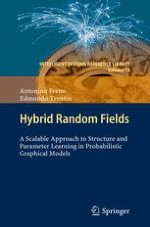2011 | OriginalPaper | Chapter
Conclusions
Authors : Antonino Freno, Edmondo Trentin
Published in: Hybrid Random Fields
Publisher: Springer Berlin Heidelberg
Activate our intelligent search to find suitable subject content or patents.
Select sections of text to find matching patents with Artificial Intelligence. powered by
Select sections of text to find additional relevant content using AI-assisted search. powered by
The time has come to summarize the main contributions we have attempted to make throughout the book. To this aim, let us look back at each one of the main chapters, in turn:
Chapters 2-3 presented the main theoretical concepts and engineering techniques related to the representation and estimation of joint probability distributions in Bayesian networks and Markov random fields. After reading them, the reader should have acquired some of the basic competences needed on the one hand to implement and use directed and undirected graphical models in application domains involving discrete variables only, and on the other hand to read more advanced literature dealing with learning techniques for (discrete) probabilistic graphical models;
Chapter 4 introduced the hybrid random field model, exploring its mathematical properties and explaining how it can be used for representing joint probabilities (via Gibbs sampling) and pseudo-likelihood functions (via simple factorization into local conditional distributions), for estimating pseudo-likelihood distributions in large-scale domains involving discrete variables (via suitable parameter and structure learning algorithms), and for accomplishing arbitrarily shaped inference tasks (again, via Gibbs sampling). After reading this chapter, readers should be able to exploit hybrid random fields as an alternative for virtually any learning and reasoning application addressed through the techniques drawn from Chapters 2-3;
Chapter 5 explained how directed, undirected, and (more explicitly) hybrid graphical models can be applied to domains involving continuous-valued variables. To this aim, three different families of (conditional) density estimation techniques were presented, i.e. parametric techniques (based on Gaussian models), semiparametric techniques (based on the nonparanormal model), and nonparametric techniques (based on kernel methods). On the other hand, the issue of structure learning in hybrid random fields was tackled from the perspective of continuous application domains, which required to suitably adapt the Markov Blanket Merging algorithm developed in Chapter 4. This chapter should have provided the reader with some tools needed for extending probabilistic graphical modeling to various kinds of densities underlying high-dimensional, continuous random vectors;
Chapter 6 presented a number of applications of probabilistic graphical models to feature selection, pattern classification, and link prediction tasks, featuring both synthetic and real-world benchmarks involving discrete and continuous variables. The considered applications allowed to evaluate the behavior of hybrid random fields from the points of view of prediction accuracy and learning scalability as well, with very promising results. After considering this chapter, readers should have gained insight into a few representative kinds of applications allowing for learning and inference through probabilistic graphical models, and especially into the practical advantages of hybrid random fields as an alternative to more traditional graphical models;
Finally, Chapter 7 investigated the relationships existing between the theoretical and application-oriented framework inspiring the research presented in this book and some epistemological questions traditionally dealt with in the philosophy of cognitive science. After delving into the arguments put forward in this chapter, the philosophically-minded reader should have realized the relevance of even the most overly technical sections of the book for a number of interesting issues in epistemology and cognitive science.
